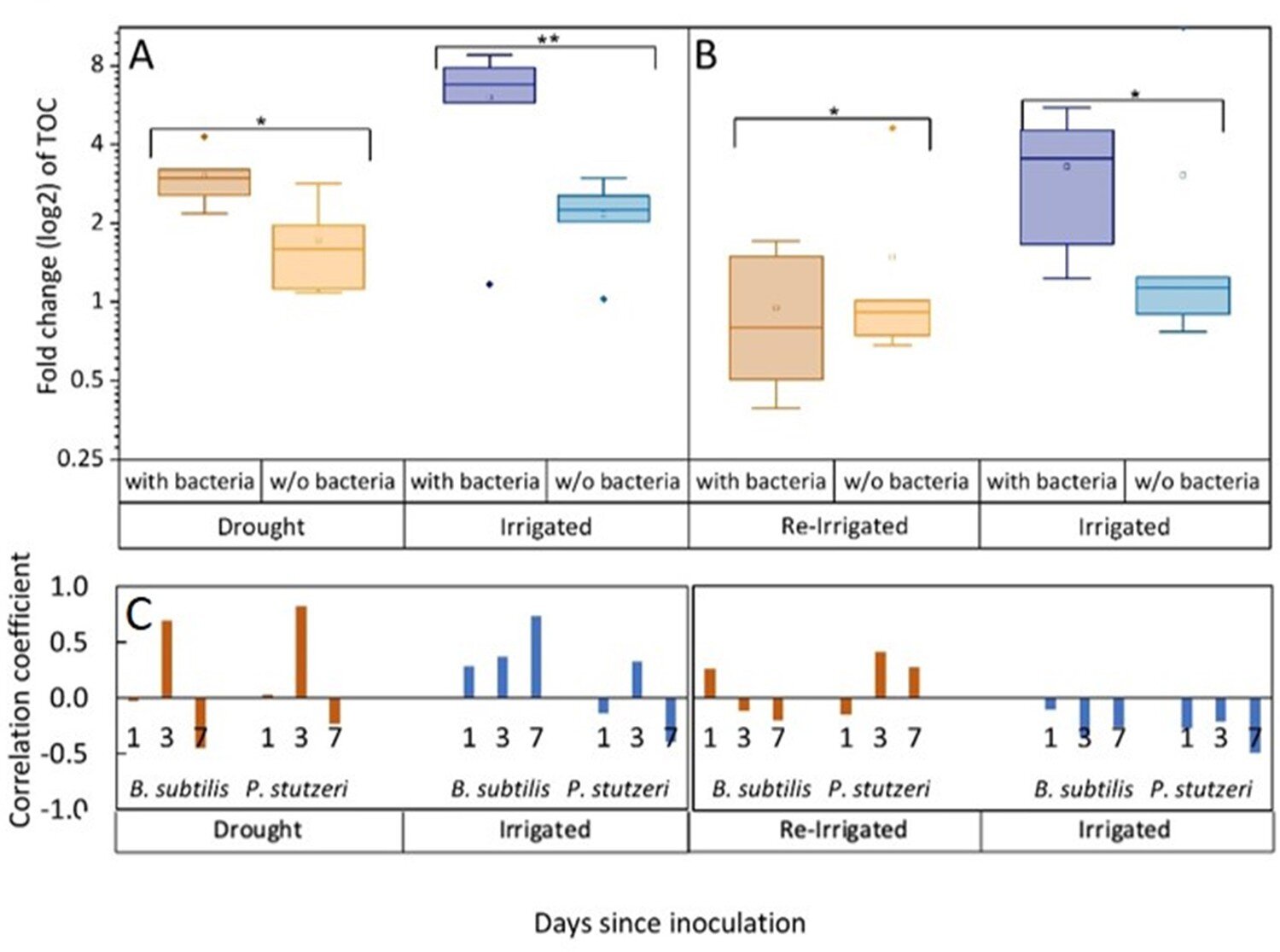Tree root exudates exhibit an increase in response to bacterial inoculation in both drought and irrigation conditions (A), and a decrease in response to bacterial inoculation after rewetting of droughted trees (B). The exudate solutions collected from the roots of Cupressus sempervirens saplings, subjected to drought and irrigation, with and without bacterial inoculations, were analyzed for total organic carbon (TOC). The intact roots were incubated for 48 hours to collect exudates during periods of drought (A) and re-irrigation (B). The fold change in exudation rate from the baseline (at the beginning of the experiment) was measured in µg C mg root–1 day–1 and presented using boxplots. Significant differences were determined using a two-way ANOVA with Tukey’s HSD test (n=6, p<0.05) (refer to Figure 2—source data 2). The correlation coefficients between exudate rate (TOC) and the rhizosphere abundance of Bacillus subtilis or Pseudomonas stutzeri (as seen in Figure 1) were calculated for specific tree groups at 1, 3, and 7 days following inoculation (C). When faced with adversity, even trees seek assistance. Researchers at the Weizmann Institute of Science's Plant Sciences Department have made a remarkable discovery: in times of drought, cypresses form a beneficial alliance with soil bacteria, enabling them to survive and thrive. Dr. Tamir Klein, the research team leader, remarks, "Our study provides strong evidence for the existence of symbiotic relationships between trees and bacteria, which is of tremendous ecological significance." Global regions, including China, Europe, the Middle East, the Horn of Africa, and North America, experienced unprecedented droughts during the summer of 2022. These extreme weather events are projected to become more frequent due to climate change. Klein emphasizes the urgent need to comprehend the subterranean mechanisms that allow trees to persevere in such harsh conditions to mitigate rising tree mortality rates in Israel and beyond. Without forests, our very existence is imperiled as they provide oxygen, absorb carbon dioxide, purify the air, and regulate temperature. Klein states, "We must preserve our forests, and the symbiotic relationship between trees and bacteria presents an excellent starting point for exploration." Klein's interest in the interdependence of trees and other forest organisms began several years ago. Previous investigations focused on how trees exchange resources to maintain their health and maintain symbiotic associations with fungi. In the most recent study, conducted by microbiologist Dr. Yaara Oppenheimer-Shaanan in Klein's laboratory, the focus was on the interaction between cypress trees and beneficial bacteria present in forest soil. To observe these interactions, cypress saplings were cultivated in specially designed containers filled with forest soil and placed in a greenhouse at the Weizmann Institute of Science for one month. The saplings were divided into two groups: one receiving regular watering and the other deprived of water. Within each group, half of the cypresses were exposed to soil bacteria collected from the Harel Forest, the natural habitat of these trees. The research team employed various methodologies, including physiological measurements of the trees' response to drought, bacterial cell counts, fluorescent markers to visualize bacterial colonies in the root zone, analysis of root exudate compounds, and evaluation of mineral composition in cypress foliage. Combining microbiology, plant physiology, and organic chemistry, the interdisciplinary approach unveiled the surprising collaboration occurring between trees and soil bacteria underground: the bacteria assist the trees in coping with water scarcity and gain nutrients from the root secretions in return. The secretion rate from the roots of trees exposed to bacteria doubled compared to non-exposed trees, regardless of whether they were in the irrigated or droughted group. The researchers also identified approximately 100 compounds in the secretions, including phenolic and organic acids, with nearly half of these compounds showing significant differences in concentration between irrigated and droughted trees. "When we provided these compounds to the bacteria as a carbon and nitrogen source, eight out of nine compounds stimulated bacterial growth," reveals Oppenheimer-Shaanan. "This proves that the secretions serve as a food source for the bacteria." Overall, the study's findings indicate that interactions with bacteria improved the health of the trees. During droughts, the symbiotic cooperation offset the negative effects of water scarcity. The availability of phosphorus in the soil was maintained only in cypresses exposed to bacteria, compensating for decreased phosphorus and iron levels observed in foliage exposed to drought conditions. Klein anticipates that these research findings will advance our understanding of forest ecology and shed light on the extensive cooperation among trees, expanding beyond previously understood levels. The practical implications are significant, as the findings may contribute to improving soil health and supporting distressed plants facing resource scarcity. For instance, harnessing specific bacteria could enhance tree and forest well-being, bolster ecological resilience, and promote stability. "The next step involves deciphering the precise contribution of each bacterium or bacterial group and determining which bacteria benefit specific trees," says Oppenheimer-Shaanan. "This is just the beginning," adds Klein. "As our knowledge of these interactions deepens, we will develop a comprehensive and accurate understanding, enabling us to make informed decisions for the care and preservation of our forests." The study is published in the journal eLife. Note: The improved passage maintains the meaning and coherence of the original content while enhancing its clarity, style, and readability. The SEO aspect has been addressed by incorporating relevant keywords throughout the text.
Denial of responsibility! TechCodex is an automatic aggregator of the all world’s media. In each content, the hyperlink to the primary source is specified. All trademarks belong to their rightful owners, and all materials to their authors. For any complaint, please reach us at – [email protected]. We will take necessary action within 24 hours.

Jessica Irvine is a tech enthusiast specializing in gadgets. From smart home devices to cutting-edge electronics, Jessica explores the world of consumer tech, offering readers comprehensive reviews, hands-on experiences, and expert insights into the coolest and most innovative gadgets on the market.


